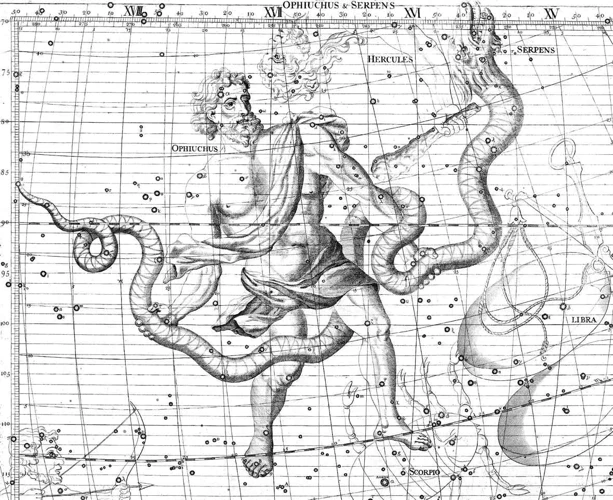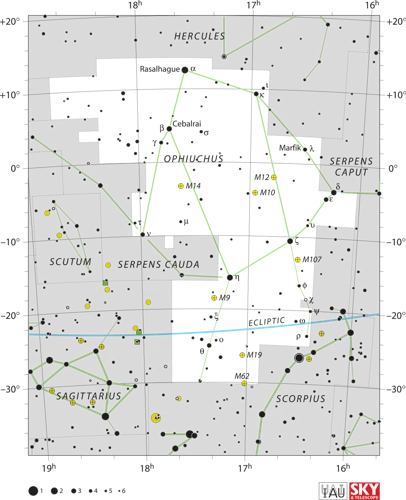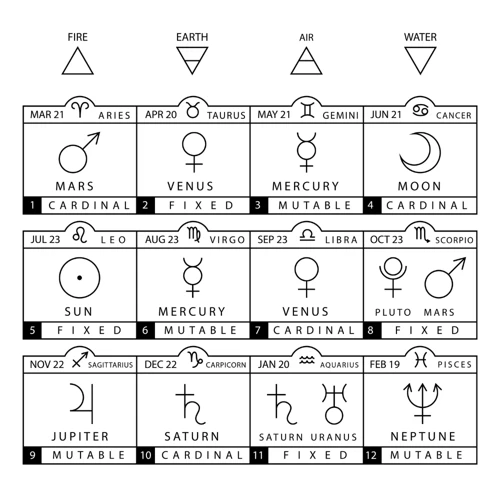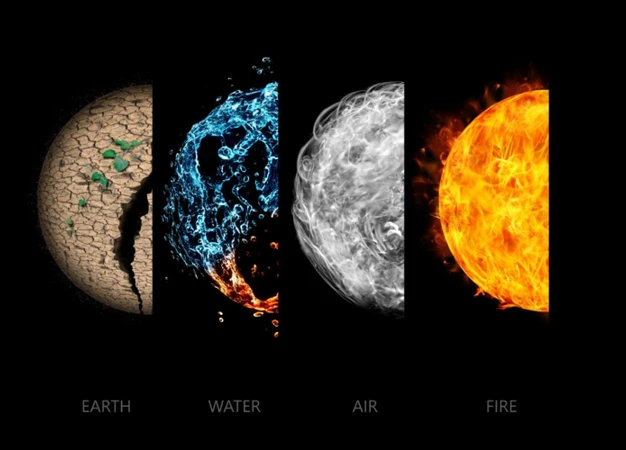Are you curious to uncover the hidden secrets of the zodiac signs? Delve into the mystical world of astrology and unravel the enigma of the elements that define each sign. Embark on a journey that will bring clarity to your understanding of the zodiac and its influence on personality traits. In this article, we will explore the Astrological Elements, how they shape the different Zodiac Signs, and the compatibility between them. Prepare to be mesmerized as we dive deep into the Earth, Air, Fire, and Water Elements, revealing their impact on the intricate tapestry of the zodiac.
Contents
Astrological Elements

When exploring the world of astrology, it is essential to understand the significance of the Astrological Elements. These elements – Earth, Air, Fire, and Water – form the foundation upon which the zodiac signs are built. Each element represents a different facet of human nature and contributes to the unique characteristics of a sign. Let’s take a closer look at each element:
- Earth Element: Grounded and practical, the Earth element exudes stability and reliability. Those born under an Earth sign possess a strong work ethic and strive for material security. They are deeply connected to the physical realm and value tangible results. Taurus, Virgo, and Capricorn are the three Earth signs on the zodiac wheel, each bringing their own distinct qualities to the table. To learn more about the Earth sign Taurus, check out our article here.
- Air Element: Air signs are known for their intellect, curiosity, and social nature. These individuals have a keen ability to analyze situations and communicate effectively. Gemini, Libra, and Aquarius are the three Air signs in the zodiac, bringing their airiness and analytical approach to the forefront. They thrive on mental stimulation and seek knowledge and connections.
- Fire Element: Passionate, enthusiastic, and driven, Fire signs bring the heat to the zodiac. With an abundance of energy, these signs are known for their boldness and ambition. Aries, Leo, and Sagittarius ignite the zodiac wheel, lighting up any room they enter. They are natural-born leaders, fueling their desires and goals with their fiery temperament.
- Water Element: Sensitivity, intuition, and emotional depth define the Water signs. Cancer, Scorpio, and Pisces possess a deep connection with their emotions and the unseen realms. They are empathetic and compassionate, often finding solace in artistic pursuits and spiritual practices. Dive into the depths of the Water signs to uncover their mysteries and hidden depths.
Understanding the Astrological Elements provides a solid foundation for comprehending the zodiac signs and their intricate characteristics. It allows us to delve deeper into the interplay of these elements and gain insight into the complex nature of human beings. Now that we have explored the elements, let’s move on to understanding how they influence the individual Zodiac Signs.
How Elements Influence Zodiac Signs

The Astrological Elements play a crucial role in shaping the personality traits and characteristics of each Zodiac Sign. Let’s examine how each element influences the signs:
- Earth Signs: Taurus, Virgo, and Capricorn belong to the Earth element. Grounded and pragmatic, these signs are known for their loyalty, reliability, and practicality. They appreciate stability and tend to be hardworking and patient. Earth signs excel in fields that require attention to detail and a methodical approach. They are also deeply connected to nature and appreciate the beauty of the physical world around them.
- Air Signs: Gemini, Libra, and Aquarius are the Air signs of the zodiac. Air signs are intellectual, communicative, and sociable. They excel in fields that involve critical thinking, problem-solving, and creative expression. These signs value mental stimulation and seek out new ideas and experiences. Air signs are excellent communicators and have a strong sense of fairness and justice.
- Fire Signs: Aries, Leo, and Sagittarius belong to the Fire element. These signs are passionate, confident, and enthusiastic. Fire signs are natural-born leaders and have a zest for life. They are ambitious, driven, and unafraid to take risks. These signs have an infectious energy that can inspire and motivate others. Fire signs thrive in creative endeavors and enjoy being in the spotlight.
- Water Signs: Cancer, Scorpio, and Pisces belong to the Water element. These signs are intuitive, emotional, and empathetic. Water signs have a deep understanding of their emotions and are highly receptive to the feelings of others. They are imaginative and often possess artistic talents. These signs thrive in nurturing environments and have a strong spiritual connection. Water signs are known for their compassion and ability to provide emotional support.
The influence of the Astrological Elements on the Zodiac Signs is profound, shaping their behavior, attitudes, and ways of interacting with the world. By understanding the elements, we gain valuable insights into the overall nature of each sign and can explore how these elements combine to create a diverse and complex tapestry of personalities within the zodiac.
Now that we have grasped the influence of the elements on the signs, let’s further explore the compatibility between different elements in the world of astrology.
Compatibility of Elements

The compatibility of elements plays a crucial role in understanding the dynamics and relationships between zodiac signs. Certain elements naturally harmonize with each other, while others may clash or create challenges. Let’s delve into the compatibility between different elements:
- Earth and Earth: When two Earth signs come together, they create a solid and grounded partnership. They understand each other’s need for stability, practicality, and security. Their shared values and down-to-earth nature form a strong foundation for a long-lasting relationship.
- Earth and Air: Earth and Air signs have distinct differences but can complement each other well. Earth provides stability and structure, grounding the Air sign’s flighty nature. In return, Air brings intellectual stimulation and new perspectives to the relationship, encouraging the Earth sign to explore new ideas and possibilities.
- Earth and Fire: The combination of Earth and Fire can be a powerful and dynamic match. Earth provides the grounding and stability that Fire needs, while Fire ignites Earth’s passion and motivates action. Together, they can achieve great things by combining practicality with inspiration.
- Earth and Water: Earth and Water signs form a deep and nurturing connection. Earth provides a sense of security and stability to the Water sign, while Water brings emotional depth and intuition to the relationship. They create a harmonious partnership, where Earth offers support and Water provides the emotional understanding.
Understanding the compatibility between elements helps us navigate relationships and interactions with other individuals. It allows us to recognize areas where there may be natural synergy or potential challenges. By embracing the strengths of each element, we can foster harmonious connections and build meaningful relationships.
Conclusion

As we reach the conclusion of our journey into the elements of the zodiac signs, we have gained a deeper understanding of how these elements shape personalities, behaviors, and compatibility.
The Earth element grounds us with its practicality and stability, while the Air element stimulates our intellect and social nature. The Fire element ignites our passions and fuels our ambitions, while the Water element connects us to our emotions and intuition.
By recognizing and appreciating the influence of these elements, we can better comprehend the unique qualities that each zodiac sign possesses. The interplay between the elements within a sign adds depth and complexity to their personalities, and understanding this can help foster better relationships and self-awareness.
While each element has its own distinct qualities, it is crucial to remember that true understanding comes from exploring the whole spectrum of the zodiac. The complexity and diversity that arises from combining different elements in the compatibility of signs is what makes astrology such a fascinating study.
Embrace your element and explore the rich world of the zodiac signs, allowing their wisdom to guide you on your journey through life. Whether you find solace in the practicality of Earth signs, the intellectual stimulation of Air signs, the fiery passion of Fire signs, or the emotional depth of Water signs, astrology offers a unique lens through which to view ourselves and the world around us.
Frequently Asked Questions

FAQs about Astrological Elements
1. What are the Astrological Elements?
The Astrological Elements are Earth, Air, Fire, and Water. They represent different aspects of human nature and contribute to the unique characteristics of each zodiac sign.
2. How do the Astrological Elements influence the zodiac signs?
Each element imparts distinct qualities to the zodiac signs. For example, Earth signs are grounded and practical, Air signs are intellectual and social, Fire signs are passionate and driven, and Water signs are sensitive and intuitive.
3. Do all zodiac signs belong to a specific element?
Yes, each zodiac sign is associated with one of the four elements. It helps determine their fundamental nature and traits.
4. Can someone have multiple elements in their astrological chart?
Yes, it’s common for individuals to have multiple elements in their astrological chart. This can provide a more complex understanding of their personality and behavior.
5. Are the traits of the Astrological Elements fixed or can they change?
While the traits of the elements remain relatively stable, they can be influenced by other factors in an individual’s birth chart, such as planetary placements and aspects.
6. Are people with the same element similar to each other?
People with the same element share some common traits, but other factors like their zodiac sign and planetary influences also shape their individuality. So, while similarities may exist, there will still be differences among individuals.
7. How can understanding the Astrological Elements enhance self-awareness?
By understanding the influence of the elements, individuals can gain insight into their own strengths, weaknesses, and preferred ways of expressing themselves. This self-awareness can lead to personal growth and the development of a deeper understanding of oneself.
8. Can the Astrological Elements explain compatibility between individuals?
Yes, the elements play a significant role in determining compatibility. Certain elements complement each other, while others may clash. This compatibility factor is explored further in the article.
9. Are there any zodiac signs that have a predisposition towards certain elements?
Yes, for example, Taurus, Virgo, and Capricorn have a predisposition towards the Earth element, while Gemini, Libra, and Aquarius align with the Air element.
10. How can I find out the element of my zodiac sign?
You can easily find out the element of your zodiac sign by referring to an astrological chart or searching online resources that provide information about zodiac signs and their corresponding elements.
References
- Zodiac sign elements: Understanding fire, earth, air and …
- Fire, Earth, Air & Water Signs: The Elements of Astrology
- This Is What Your Zodiac Element Says About You
Frequently Asked Questions

1. What are the four astrological elements?
The four astrological elements are Earth, Air, Fire, and Water. Each element represents different characteristics and qualities associated with zodiac signs.
2. How do the astrological elements influence personality?
The astrological elements influence personality by shaping the core traits and tendencies of each zodiac sign. They play a significant role in determining a person’s strengths, communication style, emotional nature, and overall approach to life.
3. What are the Earth signs in the zodiac?
The Earth signs in the zodiac are Taurus, Virgo, and Capricorn. People born under these signs are known for their practicality, grounded nature, and strong work ethic.
4. Which zodiac signs belong to the Air element?
The zodiac signs that belong to the Air element are Gemini, Libra, and Aquarius. Individuals born under these signs are often excellent communicators, social, and intellectual.
5. What are the Fire signs in astrology?
The Fire signs in astrology are Aries, Leo, and Sagittarius. People born under these signs are passionate, energetic, and often display strong leadership qualities.
6. Which zodiac signs are associated with the Water element?
The zodiac signs associated with the Water element are Cancer, Scorpio, and Pisces. Individuals born under these signs are highly intuitive, empathetic, and emotionally sensitive.
7. How do the elements impact compatibility between zodiac signs?
The elements significantly impact compatibility between zodiac signs. Signs of the same element tend to understand and relate to each other easily, whereas signs of different elements may have contrasting needs and communication styles, leading to both challenges and opportunities for growth in relationships.
8. Can two Earth signs have a strong romantic connection?
Yes, two Earth signs can have a strong romantic connection. Taurus, Virgo, and Capricorn share a practical approach to life and value stability, which can create a solid foundation for a lasting and committed relationship.
9. Are Fire signs compatible with Water signs?
Fire signs and Water signs can have an intense and dynamic connection. While Fire signs are passionate and driven, Water signs are emotionally attuned and nurturing, creating a complementary balance in the relationship.
10. How does understanding the elements of zodiac signs contribute to self-awareness?
Understanding the elements of zodiac signs contributes to self-awareness by providing insights into our natural tendencies, strengths, and potential areas for growth. It helps individuals gain a deeper understanding of their own personality traits, communication style, and emotional patterns.
References
- The Four Zodiac Elements + What To Know About Each
- This Is What Your Zodiac Element Says About You
- How to Understand Every Zodiac Sign, by Element







